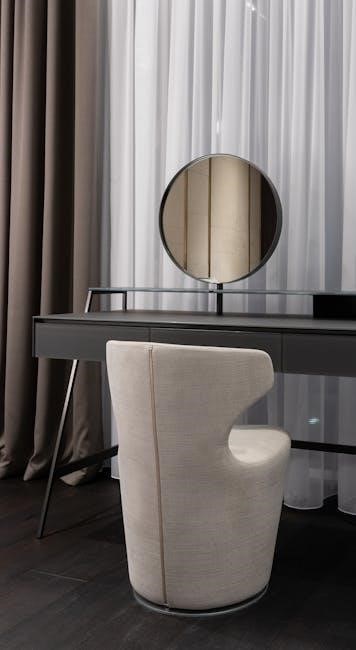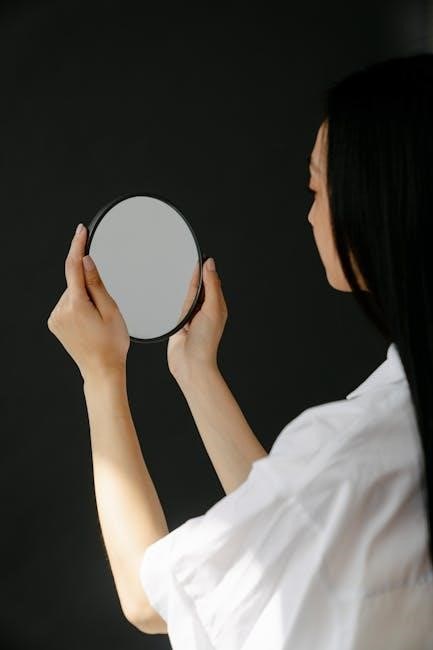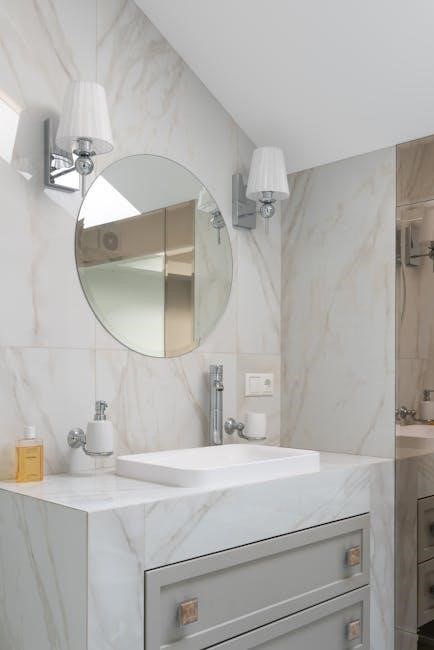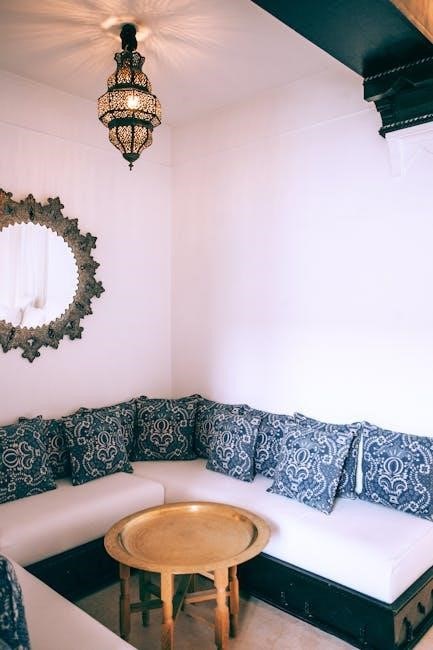Choosing the right round mirror size is crucial for both functionality and aesthetics. This guide helps you determine the perfect fit by considering room dimensions, lighting, and style preferences. Proper sizing enhances reflection and decor, ensuring a balanced and visually appealing space. Discover how to measure and select a mirror that complements your bathroom or living area seamlessly.
Understanding the Importance of Proper Mirror Sizing
Proper mirror sizing is crucial for both functionality and aesthetics. A well-sized mirror enhances reflection quality, ensures visual balance, and complements the room’s decor. It also impacts lighting perception, creating the illusion of more space. Oversized or undersized mirrors can disrupt harmony, making a room feel unbalanced. Understanding the right proportions ensures your mirror serves its purpose effectively while elevating the overall design of your space.

Factors Influencing Round Mirror Size
Room size, layout, and lighting significantly impact mirror size selection. The mirror’s purpose, whether for reflection or decoration, also plays a key role in determining its ideal dimensions.
The Role of Room Size and Layout
Room size and layout play a crucial role in determining the ideal round mirror size. Larger rooms can accommodate bigger mirrors, while smaller spaces require more compact options. The mirror’s width should typically be two-thirds to three-quarters of the vanity’s width for balance. Consider the ceiling height and furniture placement to ensure the mirror complements the space without overwhelming it. Proper sizing enhances functionality and aesthetics, creating a harmonious environment.
Mirror Purpose: Reflection vs. Decoration
The purpose of a round mirror—whether for reflection or decoration—significantly influences its size. For functional use, such as in bathrooms, the mirror should provide ample reflection, typically covering the area between the sink and lighting fixtures. Decorative mirrors, however, focus on aesthetics, often smaller in size to enhance a room’s ambiance without sacrificing style. Balancing functionality and design ensures the mirror serves its intended purpose effectively.
Impact of Lighting and Fixtures
Lighting and fixtures significantly influence round mirror size selection. In well-lit spaces, smaller mirrors can suffice, while dimly lit areas may require larger mirrors to reflect available light effectively. Fixtures like sconces or overhead lights should be considered to avoid glare. The mirror’s size and placement should balance with surrounding lighting to enhance functionality and aesthetics without creating harsh reflections. Proper coordination ensures the mirror complements the room’s ambiance and illumination needs seamlessly.

Measurement Guidelines for Round Mirrors
Measure the wall or vanity space to determine the ideal mirror size. Ensure the mirror fits the area without overwhelming it. Use a rule of thumb: two-thirds to three-quarters of the furniture’s width for balanced proportions.
Calculating Mirror Width: A Rule of Thumb
A good rule of thumb is to choose a mirror that is two-thirds to three-quarters the width of your vanity or furniture below it. This ensures ample reflection without overwhelming the space. For example, if your vanity is 48 inches wide, the mirror should be between 32 and 36 inches wide. This proportion creates a balanced look and enhances functionality. Always measure the wall or area to ensure the mirror fits seamlessly and aligns with nearby fixtures or decor.
Standard Height Ranges for Bathroom Mirrors
Bathroom mirrors typically range in height from 30 to 36 inches above the vanity countertop. This standard ensures the mirror is at eye level for most users and provides adequate lighting reflection. For double vanities, consider larger mirrors or a pair of round mirrors to maintain symmetry. Always measure the space and align the mirror with existing fixtures and decor for a cohesive look.

Special Considerations for Round Mirrors
Round mirrors add unique charm to spaces, but their placement and sizing require careful thought. They work well in smaller areas and can soften angular room designs. Consider their purpose—whether for reflection or decoration—and how they interact with lighting and surrounding decor to create a cohesive look.
Mirrors for Double Vanities: Size and Placement
For double vanities, round mirrors can add a modern touch while maintaining functionality. Opt for a size that covers at least two-thirds of the vanity width to ensure ample reflection. Mount the mirror symmetrically above the sink area, leaving space for lighting fixtures. A round mirror’s soft curves can balance the linear design of double vanities, creating a harmonious bathroom aesthetic. Consider the height placement to avoid obstructing overhead lighting while ensuring optimal visibility.
Round Mirrors Above Fireplaces: Design Rules
A round mirror above a fireplace can elevate the room’s aesthetic, but sizing is key. Choose a mirror proportional to the mantel or surround, ensuring it doesn’t overwhelm the space. Hang it 4-6 inches above the mantel for optimal placement. A round shape softens the often rectangular or linear design of fireplaces, creating a balanced look. Ensure the mirror’s diameter aligns with the room’s proportions for a cohesive, polished appearance.
Choosing the Right Size Based on Design Style
Round mirrors complement both modern and traditional designs. For modern spaces, opt for larger, statement-making mirrors, while traditional settings benefit from smaller, understated sizes that blend seamlessly with surrounding decor. Ensure the mirror’s proportions align with the room’s aesthetic to create a cohesive and visually pleasing environment.

Modern vs. Traditional: Size and Aesthetics
Modern spaces often favor larger, bold round mirrors as statement pieces, emphasizing minimalism and open layouts. Traditional settings prefer smaller, intricately framed mirrors that blend with classic decor. The size and frame style should align with the room’s aesthetic to maintain harmony. For modern designs, oversized mirrors create a sleek look, while traditional settings benefit from more modest proportions with ornate detailing to enhance timeless elegance and balance. Choose accordingly to match your design ethos.
Statement Mirrors: Size Relative to Wall Space
A statement round mirror can elevate a room’s decor by serving as a focal point. To ensure it doesn’t overwhelm the space, its size should be proportional to the wall it adorns. A good rule of thumb is for the mirror to be at least half the size of the wall or the piece of furniture it’s placed above. This balance ensures a harmonious and visually appealing environment.

Common Mistakes to Avoid
Common mistakes include choosing mirrors too small for the space, ignoring lighting effects, and not aligning the mirror’s style with the room’s decor. Proper planning is essential.
Overlooking Proportions: Vanity and Mirror Balance
One common mistake is neglecting the proportion between the mirror and vanity; A mirror that’s too small or large disrupts the balance. Aim for a mirror width that’s 70-80% of the vanity’s width for harmony. Measure accurately, ensuring the mirror complements the space without overwhelming it. Proper sizing ensures functionality and aesthetics, avoiding a disjointed look in your bathroom design.
Ignoring Wall Space: A Statement Mirror’s Impact
Ignoring wall space when choosing a statement mirror can lead to poor visual balance. A mirror that’s too small may appear out of place, while one that’s too large can overwhelm the room. Ensure the mirror is at least half the size of the wall it’s mounted on for maximum impact. Measure the wall space carefully to avoid a mismatch and create a cohesive design.

Visual Balance with Round Mirrors
Round mirrors create harmony by softening square spaces. Proper sizing and placement ensure balance, enhancing the room’s aesthetic without overwhelming it. Symmetry is key to visual equilibrium.
Creating Harmony in Bathroom Design
A well-sized round mirror enhances bathroom harmony by balancing proportions and softening angular elements. Place it centrally above the vanity, ensuring symmetry. The mirror’s width should be two-thirds to three-quarters of the vanity’s size for visual equilibrium. Proper lighting around the mirror illuminates the space evenly, creating a welcoming ambiance. This balanced approach ensures functionality while maintaining aesthetic appeal, making the bathroom feel more spacious and serene.
Mirror Placement for Optimal Aesthetics
Strategic placement of a round mirror enhances visual appeal and functionality. Position it above the vanity, aligning its center with the sink, and hang it 30 to 60 inches from the floor for optimal visibility. For larger spaces, consider placing the mirror above a fireplace or in entryways to create focal points. Ensure the mirror complements surrounding decor, balancing modern or traditional styles; Proper placement elevates aesthetics and reflects light, creating a sense of openness and harmony in any room.
Frequently Asked Questions
- How wide should a round mirror be compared to the vanity for optimal balance?
- What is the ideal height to hang a round mirror in a bathroom?
- Can a round mirror work effectively in a small bathroom setting?
How Wide Should a Mirror Be Compared to the Vanity?
A mirror should typically be two-thirds to three-quarters the width of the vanity to ensure balance and harmony in the bathroom design. Proper measurement of the vanity and consideration of the mirror’s purpose are essential. A round mirror can work well, but its size should complement the vanity’s dimensions for a cohesive look. Always measure twice to ensure the perfect fit for a polished aesthetic.
What Height is Ideal for a Bathroom Mirror?
The ideal height for a bathroom mirror is typically between 30 and 36 inches above the floor. It should be positioned 4 to 6 inches above the vanity to avoid obstructing the view. The top of the mirror should be around 6 inches below the ceiling for proportion. This height ensures functionality and aesthetics, providing a clear reflection while complementing the room’s design and ambiance.
Can a Round Mirror Work in a Small Bathroom?
A round mirror can work beautifully in a small bathroom by creating the illusion of more space and adding elegance. Its curved edges soften the room’s angularity while providing ample reflection. Choose a size proportional to the area to avoid overwhelming the space. Placing it above a vanity or as a decorative accent enhances functionality and aesthetics without compromising the bathroom’s cozy feel.
Selecting the perfect round mirror involves balancing size, style, and functionality. Measure carefully, consider your space, and choose a mirror that enhances both aesthetics and practicality for a polished look.
Final Tips for Selecting the Perfect Round Mirror
Measure your space carefully and consider the mirror’s purpose—whether for reflection or decoration. Choose a size that complements the room’s proportions and style. Ensure the mirror’s width is proportional to nearby furniture, such as your vanity or fireplace. Consider lighting to avoid glare and enhance ambiance. Finally, visualize how the mirror will interact with surrounding decor to achieve a balanced, polished look that elevates your space.
Additional Resources
Explore expert tips for hanging mirrors, design guides for bathroom layouts, and tutorials on measuring spaces effectively. These resources offer practical advice for perfect mirror placement and style.
Expert Tips for Hanging Mirrors
Ensure a straight installation by using a level. Measure twice to avoid placement errors. Consider the rule of thirds for visual appeal. Test mirror placement before final installation. For round mirrors, center them above vanities or fireplaces for symmetry. Use sturdy hardware suitable for the mirror’s weight. Check lighting reflections to enhance ambiance. Refer to design guides for specific hanging instructions and styling inspiration to achieve the perfect look in your space.

Design Guides for Bathroom Layouts
When designing a bathroom, ensure the round mirror complements the space by considering vanity width and lighting fixtures. Measure the area above the sink to determine optimal mirror size. Choose a mirror that reflects light effectively, enhancing the room’s brightness. Consider wall space and surrounding decor to maintain visual harmony. Practical tips include selecting a mirror slightly narrower than the vanity and ensuring it aligns with the room’s aesthetic for a cohesive look.

Final Tip: Measure Twice, Buy Once
Before purchasing, measure your vanity, wall space, and the area above the sink to ensure the mirror fits perfectly. Double-check dimensions to avoid returns or adjustments. Consider the mirror’s height and width relative to surrounding fixtures. Proper measurement ensures optimal light reflection and aesthetic balance. Sketch your layout or use cardboard templates to visualize placement before making a final decision for a seamless installation.